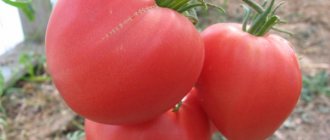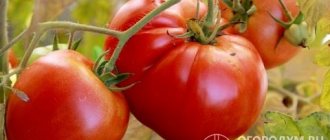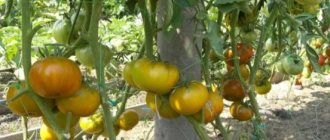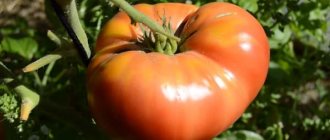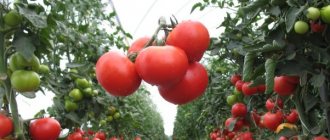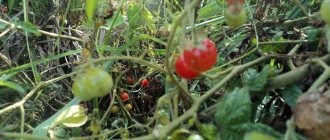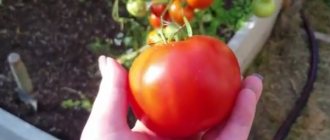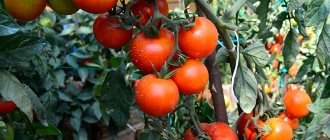Description of the tomato variety Bull's Heart Golden
The growing season is 110-120 days from the appearance of the first shoots. The hybrid is mid-season, large-fruited. The culture belongs to the determinant type of tomatoes.
The Bull's Heart bush is powerful, with medium foliage, reaches 1-1.5 m in height
Description of fruits
In the variety Bull's Heart Golden, the fruits reach large sizes as they ripen. The weight of each tomato varies from 400 to 600 g. There are specimens whose weight is 1000 g.
Important! The largest tomatoes ripen on the first bunches. Subsequent ovaries are smaller, the weight of the fruit varies from 50 to 100 g.
The color of tomatoes changes from green to golden yellow as they ripen.
The color of tomatoes changes from green to golden yellow as they ripen.
The tomatoes are cone-shaped or heart-shaped, with dense thin skin. There is a slight ribbing near the stalk. The core of the fruit is yellow, fleshy, but not fibrous, with small seed chambers.
The Ox's Heart Golden tomatoes taste very juicy and velvety. When consumed, you can note the pronounced sweetness of the tomatoes with a slight sourness.
Appearance of tomatoes
In appearance, the fruits of the Golden Heart tomato are typical hearts, that is, they are elongated and pointed towards the crown. The color of the tomato is interesting: when unripe it is yellowish, and when fully ripe it is something between golden and orange. Fruits of this shape and color seem to be honey-like, which is not far from the truth. But, fortunately, they are not so large that they cannot fit into a standard jar, and therefore can be preserved uncut.
The fruits are small, but beautiful and appetizing
Characteristics of tomato Bull's heart Golden
The variety can be cultivated both in open ground and using greenhouses. In regions with hot and long summers, gardeners successfully grow the Bull's Heart Golden tomato in garden beds. In the northern regions, it is recommended to provide tomatoes with greenhouse conditions.
Productivity and fruiting
The variety is mid-season: tomatoes ripen 100-117 days after planting. There are 3-5 tomatoes on each brush. The first wave of the harvest is larger than subsequent ones.
From 1 m2 on average you can harvest 13-15 kg of Bull's Heart Golden tomatoes.
With proper care and favorable weather conditions, the maximum indicators are 20 kg per 1 m2
Violation of the rules of agricultural technology has a negative effect on the yield: with a lack of nutrients, the fruits ripen smaller. If you plant bushes in a different pattern, the tomatoes will ripen more slowly.
Area of application of fruits
Tomatoes Bull's Heart Golden are more often used for preparing salads, since the first fruits of the variety are large. Smaller tomatoes are suitable for whole-fruit canning.
Vegetables are rarely used for preserving tomato paste and juices because of their color. Tomatoes are not suitable for sale and long-term transportation: their skin is thin and easily damaged.
Resistance to diseases and pests
The Bull's Heart Golden variety is characterized by a strong immune system. With improper care or unfavorable natural conditions, the variety can be affected by fungal diseases.
At high humidity there is a risk of brown spot development. Symptoms often appear during flowering or fruiting.
It can be recognized by round yellowish spots located on the upper part of the leaf blade. There is a brown coating on its reverse side. Without treatment, the above-ground part of the bush dries out and the tomato dies.
If you plant crops close to each other in soil contaminated with fungi, then with high humidity, root rot may develop.
The stem of the diseased tomato Bull's Heart Golden darkens and becomes thinner. The plant quickly dies.
More often, root rot occurs in greenhouses, where it is humid and hot.
Advantages and disadvantages
The variety is known among gardeners as high-yielding and large-fruited. People are also attracted by the unusual, rich yellow color of the skin of the Bull's Heart Golden tomatoes.
Tomatoes have practically no seeds, tender pulp and a balanced taste - sweet, sugary, with a hint of sourness.
pros
- resistance to heat; the possibility of growing crops in all regions of Russia;
- ease of care;
- extended fruiting period; vegetables can be harvested from June until frost.
Minuses
- fruits do not tolerate long-term transportation;
- tomatoes crack when hit because the skin is very thin;
- the bush needs a garter.
And although the first ripened tomatoes cannot be used for whole-fruit canning due to their size, the second wave of the harvest will be smaller, and therefore suitable for processing.
A little history
The tomato is the fruit of a perennial nightshade plant called tomato.
This word and the plant itself came to Russia from France, and to France from Italy, presumably in the 16th century. In Italy, the plants were called pomo d'oro - “golden apple” and they were yellow-sunny in color, because this is how the Mays and Aztecs grew them, believing that “tomatli” were sent to them by the solar goddess of medicine, health and healing - Ishtilton (Ichtilton) .
The Spaniards, who introduced Europe to this golden berry after 1520, introduced it as “pomidel de Peru” - “apple from Peru.” The loving French gave the “apple” its own name, which was used by the Russians for a long time - “une pomme d'amour” - “love apple”.
Both the French and the Spaniards used tomatoes as a remedy for coughs and as a powerful remedy for increasing potency, but frequent consumption of la mela d'oro (“golden apple” - Italian), according to scientists of that time, threatened death.
Such a gift for anyone's heart!
In 1780, new fruits from Italy were served at the table of Catherine the Second, most of which were “golden apples”. The empress liked the new fruit so much that by the greatest decree it was ordered to plant this vegetable for the imperial table and the process of Russification of the Italian “love” berry took on unprecedented proportions.
Oh, the queen didn’t know that tomatoes had long been settled on the outskirts of the Russian Empire as a medicinal vegetable, and Crimeans, Astrakhan, Georgians and other southerners had long mastered the methods of growing French-Italian berries!
By the middle of the 19th century, the area under cultivation of tomatoes developed in Russia was several times larger than the modest beds of all those countries through which the tomato passed to become “in the board” for Russians.
So who is he - Senor Tomato ? By definition, it is a fruit. In the everyday consciousness - a vegetable. According to biological classification - berry. And this fruit and vegetable has long become the king of our greenhouses and gardens!
What varieties of tomatoes does the 21st century offer us?
Features of cultivation
The seedling cultivation period is 50-65 days, so all sowing procedures are carried out in mid-March.
Containers should be washed and dried. You need to make sure that there are ventilation holes in them.
Tomato seeds are processed by the manufacturer and therefore do not require disinfection.
Landing algorithm:
- Fill the soil with soil.
- Make furrows up to 1-1.5 cm deep.
- Spread the seed and sprinkle it with soil.
- Moisten the soil mixture.
- Cover the container with glass or cling film.
Until the seeds have sprouted, the room temperature should be maintained at 21-23 °C. As soon as shoots are noticeable, remove the cover. Plant the seedlings after the true leaves appear.
During picking, the integrity of the earthen coma should be preserved as much as possible in order to speed up the rooting process
Two weeks before transferring the seedlings to a permanent place, harden the Bull's Heart Golden tomatoes. The container with tomatoes must be taken outside, gradually increasing their time spent outdoors.
Landing algorithm:
- Prepare holes according to the 50*70 cm pattern.
- Carefully remove the tomato, preserving the earthen lump as much as possible, and then move it to the hole.
- Cover the seedling with soil and compact the soil mixture around it.
- Water the tomatoes generously Bull's Heart Golden.
Important! The optimal time for the procedure is early morning or evening. It is allowed to plant tomatoes in cloudy weather.
A mandatory step in caring for tall tomatoes is gartering. Immediately after planting, you should build a trellis by digging support pillars on the sides of the bed. Stretch a wire between the tops.
Each of the tomatoes should be carefully tied to the trellis with a rope or twine
Important! You need to tie up the shoots as they grow throughout the season, carefully distributing them so that they do not get tangled or fall.
It is recommended to form a tomato Bull's heart Golden into one stem
The variety begins to lay flowers after 9-12 leaf blades. Brushes are formed every three sheets.
Stepchildren must be removed throughout the season, carrying out the manipulation in the morning. Shoots whose length does not exceed 7 cm must be pruned.
When removing stepchildren, it is important to leave a “stump”
To get a good harvest, it is recommended to fertilize:
- The first procedure is 10-15 days after planting, use organic fertilizers.
- During the flowering period, give preference to mineral compositions containing potassium and phosphorus.
- After fruit set, superphosphate is added to the bed to speed up ripening.
The crop should be watered regularly, alternating the procedure with loosening. After the plant takes root and grows, it is recommended to mulch the tomato bed with grass or sawdust.
Care
When growing tomatoes, you need to properly care for the bushes.
Watering
Tomatoes do not like severe droughts and excess water. Therefore, they need to be watered only when the soil dries out. It is enough to do this once every 10 days. During the formation of ovaries on the bushes, the plants are watered several times a week.
It is recommended to water tomatoes using the drip method, as this helps increase productivity. At the same time, you need to add a little ash to the water so that the bushes grow better and get sick less often.
Top dressing
You need to fertilize tomatoes at least three times a season. To do this, it is recommended to use fertilizers that contain little nitrogen and a lot of phosphorus. You can also feed the bushes with macrofertilizers: boron and magnesium. They strengthen tomato flowers and prevent them from falling off.
Formation of bushes
This variety of tomato must be formed into one stem. Stepsoning is carried out when a large number of stepsons appear on the bush. They need to be removed before they grow to 4 cm in length. First, the stepsons are planted under the tassels. If this is not done in time, the tomato will shed its ovary and flowers.
You need to carry out pinching constantly, no matter how many stems you need to leave. The only limitation is that you cannot prune grown bushes in hot weather, since under such conditions they do not cope well with injuries. In summer, pinching is carried out only in cloudy and rainy weather.
Pest and disease control
To prevent the Bull's Heart Golden variety from being susceptible to fungal diseases, preventive measures should be taken:
- dig up the area in autumn and spring;
- disinfect the soil before planting seedlings;
- purchase seed only from trusted suppliers.
If signs of root rot appear, measures should be taken to dry the soil: loosen it, cover it with sand. Sprinkle the soil mixture with a weak solution of manganese to disinfect.
In the later stages, the Golden Bull's Heart tomato cannot be cured. The bush is subject to destruction; preventive measures are taken in relation to other plants.
Remedies containing copper are effective against olive spot. It is recommended to treat the bushes with Barrier or Barrier.
Reviews from gardeners
Dusya, Nikolaev
I grew Ox's Heart two seasons ago. Indeed, the fruits become very small after the 2nd brush. Of course, tomatoes are excellent, but low-yielding.
Source: dacha.wcb.ru
Lolochka, Nizhny Novgorod
I am a first-year gardener, I grew everything for the first time. "B. Heart" grew delicious, large, almost without seeds, the largest one turned out to be 670 grams.
Source: www.forumhouse.ru

